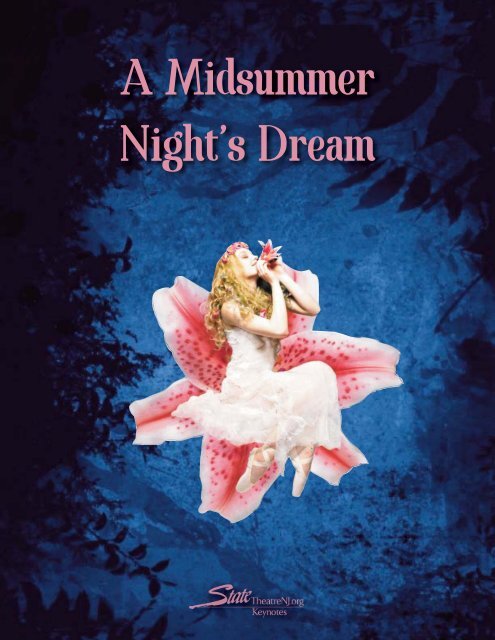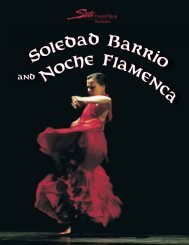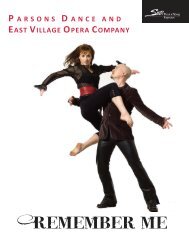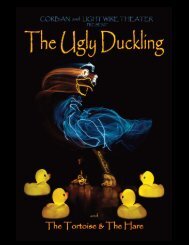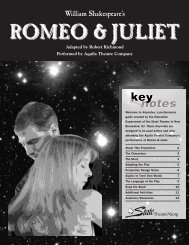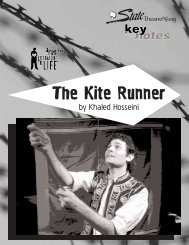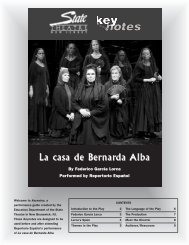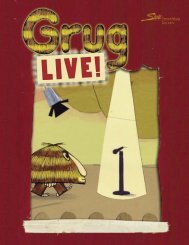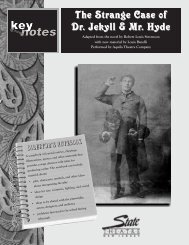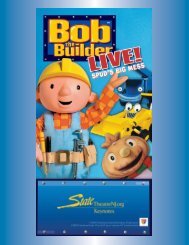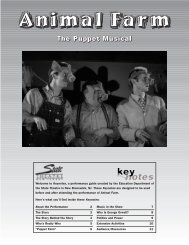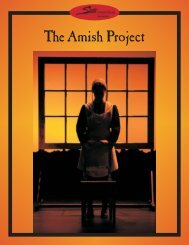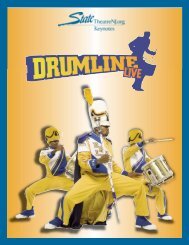A Midsummer Night's Dream - State Theatre
A Midsummer Night's Dream - State Theatre
A Midsummer Night's Dream - State Theatre
You also want an ePaper? Increase the reach of your titles
YUMPU automatically turns print PDFs into web optimized ePapers that Google loves.
A <strong>Midsummer</strong><br />
Night’s <strong>Dream</strong>
2<br />
Welcome!<br />
Welcome to the <strong>State</strong> <strong>Theatre</strong>’s<br />
school-day performance of A<br />
<strong>Midsummer</strong> Night’s <strong>Dream</strong>. In<br />
BAMA <strong>Theatre</strong> Company’s inspired<br />
production, eight amazing actors<br />
magically morph into 22 different<br />
characters<br />
These Keynotes will help you<br />
and your students prepare for the<br />
show. Besides exploring the plot,<br />
characters, and background of the<br />
play, the materials will help<br />
audiences recognize and<br />
appreciate the theatrical elements<br />
that set this production apart from<br />
other versions of A <strong>Midsummer</strong><br />
Night’s <strong>Dream</strong> you may have seen.<br />
Enjoy the show!<br />
Contents<br />
Welcome! ....................................................2<br />
Shakespeare & A <strong>Midsummer</strong><br />
Night’s <strong>Dream</strong> ......................................3<br />
The Story......................................................4<br />
Follow the Map! ........................................5<br />
About This Production............................6<br />
Staying on Track........................................7<br />
What’s It All About? ................................8<br />
One Play, Many Stories ..........................9<br />
Meet BAMA <strong>Theatre</strong> Company............10<br />
Resources ....................................................11<br />
During the Show ......................................12<br />
Keynotes are made possible by a<br />
generous grant from Bank of America<br />
Charitable Foundation.<br />
The <strong>State</strong> <strong>Theatre</strong>’s education program is funded in part by Bank of America Charitable Foundation, Colgate-<br />
Palmolive, The Geraldine R. Dodge Foundation, E & G Foundation, Gannett Foundation, The William G. & Helen C.<br />
Hoffman Foundation, The Horizon Foundation for New Jersey, Johnson & Johnson Family of Companies, J. Seward<br />
Johnson, Sr. 1963 Charitable Trust, Karma Foundation, The Blanche and Irving Laurie Foundation, McCrane<br />
Foundation, MetLife Foundation, Mid Atlantic Arts Foundation, National Starch, New England Foundation for the<br />
Arts, New Jersey <strong>State</strong> Council on the Arts, Pennsylvania Performing Arts on Tour, Bill & Cathy Powell, The<br />
Provident Bank Foundation, PSE&G, Robert Wood Johnson Foundation, TD Bank, and Wachovia Wells Fargo<br />
Foundation. Their support is gratefully acknowledged.<br />
The presentation of A <strong>Midsummer</strong> Night’s <strong>Dream</strong> is supported in part by PSE&G.<br />
Keynotes are produced by the Education<br />
Department of the <strong>State</strong> <strong>Theatre</strong>,<br />
New Brunswick, NJ.<br />
Mark W. Jones, President & CEO<br />
Lian Farrer, Vice President for Education<br />
Online at www.<strong>State</strong><strong>Theatre</strong>NJ.org/Keynotes<br />
Keynotes for A <strong>Midsummer</strong> Night’s <strong>Dream</strong> written<br />
and designed by Lian Farrer.<br />
Edited by Jennifer Cunha.<br />
© 2010 <strong>State</strong> <strong>Theatre</strong><br />
Funding has been made possible in<br />
part by the New Jersey <strong>State</strong><br />
Council on the Arts/Department of<br />
<strong>State</strong>, a partner agency of the<br />
National Endowment for the Arts.<br />
Continental<br />
Airlines is the<br />
official airline<br />
of the <strong>State</strong><br />
<strong>Theatre</strong>.<br />
The Heldrich<br />
is the official<br />
hotel of the<br />
<strong>State</strong> <strong>Theatre</strong>.<br />
Find us at www.<strong>State</strong><strong>Theatre</strong>NJ.org<br />
Contact: education@<strong>State</strong><strong>Theatre</strong>NJ.org<br />
The <strong>State</strong> <strong>Theatre</strong>, a premier nonprofit venue for the<br />
performing arts and entertainment.
3<br />
Shakespeare &<br />
A <strong>Midsummer</strong><br />
Night’s <strong>Dream</strong><br />
“Lord, what fools these mortals be!”<br />
—Puck, Act 3, Scene 2<br />
Shakespeare’s comedy, A <strong>Midsummer</strong> Night’s <strong>Dream</strong>, was first<br />
performed somewhere between 1595 and 1596. The play weaves<br />
together characters and stories from very different worlds: mythical<br />
heroes from ancient Greece, sprites and fairies, two human couples,<br />
and a group of bumbling craftsmen. On <strong>Midsummer</strong> Eve, their lives and<br />
stories intersect in unexpected ways, with adventures and<br />
misadventures that eventually lead to a happy conclusion.<br />
A poet as well as a playwright, William Shakespeare (1564-1616) is<br />
the most celebrated and influential writer of any era. Despite the<br />
passage of more than 400 years, his plays are constantly being<br />
performed around the world. They have been the inspiration for<br />
countless films, novels, poems, and operas, and even other plays. After<br />
the Bible, he is the second-most quoted writer in the history of the<br />
English language. Shakespeare’s popularity and influence are universal;<br />
at the Shakespeare Centre in Stratford-upon-Avon, the library<br />
collection includes editions of the plays and poems in over 80<br />
languages, from Arabic and Albanian to Yakut and Zulu.<br />
Shakespeare’s influence extended over the English language itself.<br />
No one knows exactly how many new words he created; the estimates<br />
run from a few dozen to ten thousand. Some of the words that are first<br />
seen in his plays include accessible, amazement, assassination,<br />
barefaced, bedazzle, belongings, circumstantial, courtship, critical,<br />
dewdrop, downstairs, employer, epileptic, exposure, fairyland,<br />
fashionable, frugal, homely, impartial, lament, leapfrog, majestic,<br />
moonbeam, paternal, puke, rant, reclusive, roadway, sacrificial,<br />
schoolboy, silliness, useful, vulnerable, watchdog, and zany.<br />
<strong>Midsummer</strong> is a holiday that has been celebrated since<br />
ancient times. It takes place during the summer solstice, the<br />
longest day of the year. In England, <strong>Midsummer</strong> was<br />
celebrated with parades, bonfires, feasting, and dancing.<br />
During Shakespeare’s time, some people believed that<br />
<strong>Midsummer</strong> Night had a special magic. Sprites and fairies<br />
had stronger powers. Flowers gathered on this night could<br />
work magic. People dreamed visions of their true loves.<br />
Some even went insane. From the title alone, Shakespeare’s<br />
audiences would have understood that A <strong>Midsummer</strong><br />
Night’s <strong>Dream</strong> would be about love, magic, and madness.
4<br />
The Story<br />
In Athens, Theseus prepares for<br />
Hermia and Lysander (the man<br />
Demetrius and Helena used to<br />
The six mechanicals discuss a<br />
his wedding to Hippolyta.<br />
she loves) decide to run away<br />
be a couple, but he broke up<br />
play called Pyramus and Thisbe,<br />
Egeus comes to demand that<br />
and be married. They agree to<br />
with her. Desperate to win him<br />
which they will perform at the<br />
his daughter Hermia be forced<br />
meet in the forest outside of<br />
back, Helena decides to tell him<br />
wedding of Theseus and<br />
to marry Demetrius. According<br />
town the following night.<br />
about Hermia and Lysander’s<br />
Hippolyta. They agree to<br />
to ancient law, Hermia must<br />
Hermia confides in her friend<br />
plan to elope.<br />
rehearse later in the woods<br />
obey her father, or else be sent<br />
Helena about the plan.<br />
outside the city.<br />
to a convent or put to death.<br />
Puck, a mischievous spirit,<br />
Oberon decides to get back at<br />
Oberon sees Helena chasing<br />
As Titania lies sleeping, Oberon<br />
works for Oberon, the King of<br />
Titania. He orders Puck to find<br />
Demetrius through the woods.<br />
applies the magic juice to her<br />
the Fairies. Puck explains that<br />
a magic flower. If you put the<br />
He feels sorry for her and<br />
eyes.<br />
Oberon’s wife, Titania, Queen of<br />
juice from this flower on<br />
orders Puck to put the flower<br />
the Fairies, has stolen a young<br />
someone’s eyes, they will fall<br />
juice in the eyes of the young<br />
boy from Oberon. Oberon is<br />
madly in love with the first<br />
man (meaning Demetrius) to<br />
furious, and exchanges some<br />
creature they see.<br />
make him fall in love with<br />
bitter words with Titania.<br />
Helena when he wakes up.<br />
Puck finds Hermia and Lysander<br />
Helena comes across the<br />
In another part of the forest,<br />
Bottom can’t understand why<br />
asleep in the woods. He<br />
sleeping couple. Lysander<br />
Puck sees the mechanicals<br />
his friends fled from him. He<br />
mistakes Lysander for<br />
wakes up and the first thing he<br />
rehearsing their play. Just to<br />
wanders through the forest and<br />
Demetrius and puts the flower<br />
sees is Helena. He falls instantly<br />
make mischief, he magically<br />
comes across the sleeping<br />
juice in his eyes.<br />
in love with her and starts<br />
transforms Bottom’s head into<br />
Titania. She awakens and<br />
chasing her through the forest,<br />
a donkey’s head. Terrified, the<br />
immediately falls in love with<br />
leaving behind the sleeping<br />
mechanicals run away from<br />
the donkey-headed Bottom.<br />
Hermia.<br />
their friend.<br />
Puck tells Oberon that Titania is<br />
When Demetrius falls asleep,<br />
Hermia arrives and accuses<br />
Furious with Puck for causing<br />
in love with a donkey.<br />
Oberon applies the juice to his<br />
Helena of stealing Lysander’s<br />
so much trouble, Oberon<br />
Demetrius appears, along with<br />
eyes. Demetrius awakens, sees<br />
affections. Lysander continues<br />
orders him to remove the<br />
Hermia, who is desperately<br />
Helena, and falls in love with<br />
to fight with Demetrius over<br />
flower juice from Lysander’s<br />
trying to find Lysander. Oberon<br />
her on the spot. Now both<br />
Helena. The two men go off to<br />
eyes so he will fall back in love<br />
realizes that Puck put the magic<br />
Lysander and Demetrius are in<br />
fight a duel. All four Athenians<br />
with Hermia. He casts a spell to<br />
juice into the wrong man’s eyes.<br />
love with Helena. She is sure<br />
set off through the forest. Puck<br />
make Hermia, Helena, Lysander,<br />
He sends Puck to find Helena.<br />
they’re just making fun of her.<br />
makes sure they lose one<br />
and Demetrius fall asleep.<br />
another.<br />
Surrounded by her fairies,<br />
Titania lavishes kisses and<br />
caresses on the donkey-headed<br />
Bottom. Oberon feels sorry for<br />
her and releases her from the<br />
spell. Puck transforms Bottom<br />
back into human form.<br />
Theseus leads a hunting party<br />
in the woods. They come across<br />
the two couples asleep on the<br />
ground. Demetrius tells Egeus<br />
that he loves Helena and no<br />
longer wishes to marry Hermia.<br />
Theseus declares that there will<br />
be a triple wedding.<br />
Back in Athens, the mechanicals<br />
are upset about Bottom’s<br />
disappearance. He arrives just<br />
in time to join the celebration.<br />
The wedding couples and their<br />
guests watch in amusement as<br />
the mechanicals act out the<br />
story of Pyramus and Thisbe.<br />
The three newlywed couples<br />
retire to bed. Oberon and<br />
Titania give their blessing to<br />
the marriages. Puck turns to<br />
the audience to say the whole<br />
thing has been a dream.
5<br />
Follow<br />
the Map!<br />
EGEUS<br />
Wants Theseus<br />
to force Hermia<br />
to marry<br />
Demetrius<br />
asks for help<br />
THESEUS<br />
King of Athens<br />
engaged to<br />
HIPPOLYTA<br />
Queen of the<br />
Amazons; defeated<br />
by Theseus<br />
This map shows the<br />
complicated<br />
relationships among the<br />
characters in the play.<br />
Can you follow the<br />
map?<br />
Key<br />
The Royals<br />
The Lovers<br />
The Mechanicals<br />
The Fairies<br />
Other Humans<br />
father of<br />
HERMIA<br />
Facing death for<br />
refusing to marry<br />
Demetrius<br />
friends<br />
HELENA<br />
Loved by<br />
Demetrius, until<br />
he dumps her<br />
for Hermia<br />
truly loves<br />
loves because of the flower juice<br />
loves<br />
LYSANDER<br />
The man Hermia<br />
wants to marry,<br />
against her<br />
father’s wishes<br />
uses flower juice on<br />
uses flower juice on<br />
serves<br />
PUCK<br />
A mischievous<br />
fairy<br />
OBERON<br />
King of the Fairies<br />
married to<br />
True Feelings<br />
loved, then didn’t<br />
Under a Spell<br />
AMAZONS - a nation of<br />
female warriors<br />
MECHANICAL - In<br />
Shakespeare’s time, it<br />
meant someone from the<br />
lower class who works at a<br />
manual trade, such as a<br />
carpenter or bricklayer.<br />
truly loves<br />
loves because of the flower juice<br />
PETER<br />
QUINCE<br />
Writes Pyramus<br />
and Thisbe<br />
PLAYERS<br />
Along with Bottom, the<br />
men who perform in<br />
Pyramus and Thisbe:<br />
Flute, Snout, Snug, and<br />
Robin Starveling<br />
DEMETRIUS<br />
The man Egeus<br />
wants Hermia<br />
to marry<br />
transforms into a donkey<br />
BOTTOM<br />
A weaver who plays<br />
Pyramus in the playwithin-a-play<br />
loves because of the flower juice<br />
TITANIA<br />
Queen of the Fairies<br />
FAIRIES<br />
Servants of Titania:<br />
Peaseblossom,<br />
Cobweb, Moth, and<br />
Mustardseed
6<br />
About This<br />
Production<br />
8 actors. 22 roles. 1 trunk. Proof that magic still exists.<br />
BAMA <strong>Theatre</strong> Company performs Shakespeare’s A <strong>Midsummer</strong> Night’s <strong>Dream</strong> with<br />
just eight actors, some costume pieces, and a stage that is completely bare, except for a<br />
large trunk. There are no high-tech visual effects, no recorded music or sound effects.<br />
All of the theatrical magic is created by the actors themselves.<br />
Why did the company decide to do away with many of the elements we associate<br />
with live theater?<br />
“The emphasis for us was always on Shakespeare’s<br />
words,” says Greg Foro, BAMA’s co-artistic director. “For<br />
us, that meant there would be no extravagant costumes<br />
or sets to distract the audience from the real ‘meat’ of<br />
the play. We asked ourselves the question: Would a<br />
modern audience see Shakespeare in a different way?”<br />
Without the usual visual cues to identify the<br />
“What if the audience was<br />
simply asked to hear the<br />
poetry and see the play come<br />
to life in its purest form?”<br />
—Greg Foro<br />
characters and settings, how do you keep the audience from getting lost?<br />
Greg explains: “We chose basic costumes with one or two identifying pieces so that<br />
the audience knows right away who each character is. For instance, an actor may be in<br />
basic black, but when he becomes Oberon, he need only put on a large cloak. When he<br />
becomes one of the mechanicals, a simple vest and glasses will tell the audience right<br />
away that there has been a change.”<br />
Performing a play with 22 characters using only eight actors means that everybody<br />
has to contribute at all times. Each actor plays at least two and as many as four roles.<br />
(To see how this is done, read page 7, “Staying on Track.”) When the show begins, the<br />
company uses blue tape to mark off a big rectangle on the stage floor. The story is<br />
played out inside the rectangle. Actors who aren’t in a scene remain onstage, outside<br />
the box, where they continue to be part of the performance. They use their voices and<br />
bodies to create sound effects that help create a specific mood that adds to the drama.<br />
Alison Frederick, the company’s co-artistic director, comments: “Each member of the<br />
company is showing his/her support for his/her fellow actors as well as for the integrity<br />
of the piece by being present….literally. The energy coming from outside the playing<br />
space is just as important as what comes from within.”<br />
During the performance, pay<br />
particular attention to:<br />
• The actors on the sidelines. How<br />
do they help tell the story in<br />
scenes that don’t include them?<br />
• How the actors make their<br />
transitions from one character<br />
to another.<br />
• How the actors suggest the<br />
various locations in the play<br />
without having any scenery or<br />
special visual effects to help.<br />
• Your own reactions. Are you<br />
enjoying the performance? Can<br />
you follow the story? Can you<br />
understand what the characters<br />
are saying?
7<br />
Staying on Track<br />
The ‘Mechanicals’ present their play. Left to right:<br />
Starveling, Snout, Flute, Bottom, Peter Quince, and Snug.<br />
BAMA <strong>Theatre</strong> Company’s eight actors portray all 22<br />
characters in A <strong>Midsummer</strong> Night’s <strong>Dream</strong>. To make this work,<br />
each actor is assigned a ‘track’—anywhere from two to four<br />
roles they will play in the show.<br />
Figuring out the tracks was a complicated puzzle. First of<br />
all, the company had to make sure that the same actor wasn’t<br />
assigned to play more than one character in the same scene.<br />
The first thing the company did when they decided to<br />
perform A <strong>Midsummer</strong> Night’s <strong>Dream</strong> was to map out, on a<br />
grid, the characters that appear in each scene. First they made<br />
the obvious choices for the major characters. Then they<br />
worked out which actors would be available to take on the<br />
other roles.<br />
Because the play has more male than female characters, it<br />
became clear that some of the male roles would have to be<br />
played by women. BAMA’s Allison Frederick enjoys the<br />
challenge. “In Shakespeare’s time it was normal for men to<br />
play all the parts, including the female roles, because women<br />
were not allowed on the stage. Thankfully, that is no longer<br />
the case. Not only can women be in Shakespeare’s plays, they<br />
can play any role they want. It’s high time that women got in<br />
on the action!”<br />
The Grid<br />
William Greg Alison Nathan Nick Lauren Anne Chris Sarah<br />
A1, S1 A1, S2 A1, S3 A2, S1 A2, S2 A2, S3 A2, S4 A2, S5 A2, S6 A3, S1 A3, S2 A3, S3 A3, S4 A3, S5 A4, S1 A4, S2 A4, S3 A5, S1 A5, S2 A5, S3<br />
Theseus<br />
Egeus<br />
Lysander<br />
Demetrius<br />
Philostrate<br />
Peter Quince<br />
Bottom<br />
Flute<br />
Snout<br />
Snug<br />
Starveling<br />
Hippolyta<br />
Hermia<br />
Helena<br />
Oberon<br />
Titania<br />
Puck<br />
Peaseblossom<br />
Cobweb<br />
Moth<br />
Mustardseed/First Fairy
8<br />
What’s It<br />
All About?<br />
“Innocent fantasy or sinister<br />
nightmare—A <strong>Midsummer</strong> Night’s<br />
<strong>Dream</strong> seems in the 20th century, at any<br />
rate, to yield anything we might wish to<br />
find in it.”<br />
—R.A. Foakes<br />
“For me, it is ‘bully Bottom’s’ play,<br />
though its four realms of being—<br />
fairies, ancient Athenians,<br />
contemporary rustics, and erotically<br />
confused young women and men—<br />
all afford extraordinary vistas upon<br />
colliding dreams and realities.”<br />
—Harold Bloom<br />
Ask ten Shakespeare scholars, ten actors, or ten theatergoers to<br />
identify the main theme of A <strong>Midsummer</strong> Night’s <strong>Dream</strong>, and you<br />
might get ten different answers. No one answer will be the ‘right’<br />
one or the ‘wrong’ one. That’s one of the things we love about this<br />
play, and most plays in general: it invites us to create our own<br />
meaning; to see the story and characters through our own eyes.<br />
That’s why every production of A <strong>Midsummer</strong> Night’s <strong>Dream</strong> is<br />
different from the others. Each interpretation uses the same<br />
words—the ones Shakespeare wrote. But every new creative team<br />
(director, designers, actors, etc,) has their own ideas about the play.<br />
They make artistic choices that will affect how the audience sees<br />
the play.<br />
What do you think is the main theme of A <strong>Midsummer</strong> Night’s <strong>Dream</strong>?<br />
Write an essay explaining your choice. Include at least five lines or speeches<br />
from the play that support your opinion.<br />
Create a collage of A <strong>Midsummer</strong> Night’s <strong>Dream</strong> that represents your<br />
personal understanding and interpretation of the play. Incorporate a variety<br />
of materials to give your collage visual interest.<br />
Watch at least two of the film versions of A <strong>Midsummer</strong> Night’s <strong>Dream</strong>.<br />
(See the list on page 10 of this guide.) Compare and contrast: How is the<br />
meaning of the play the same in each version? How is it different? What are<br />
the specific elements (performances, lighting, costumes, settings, etc.) that<br />
change the audience’s understanding of the play?<br />
“The whole question which is<br />
balanced, and balanced nobly<br />
and fairly in A <strong>Midsummer</strong><br />
Nightʼs <strong>Dream</strong>, is whether the<br />
life of waking, or the life of the<br />
vision, is the real life of man.”<br />
̶G.K. Chesterton<br />
“Our version of A <strong>Midsummer</strong> Nightʼs <strong>Dream</strong> is<br />
about the magic of love. Love touches<br />
everyone: young and old, rich and poor, those<br />
who return it and those who run from it. Any<br />
way you find it, love changes you. It builds you<br />
up and makes you believe that anything is<br />
possible. It turns a gaggle of amateur actors<br />
into a class act, fit for a king. It inspires lovers<br />
to brave the forest in the hopes of finding a<br />
brighter tomorrow. It can even alter nature and<br />
change the seasons when the King and Queen<br />
of the Fairies are in love. Love inspires us to be<br />
a part of something greater than ourselves and<br />
that is what makes it truly magical.”<br />
̶Alison Frederick,<br />
BAMA <strong>Theatre</strong> Company
9<br />
One Play, Many Stories<br />
A <strong>Midsummer</strong> Night’s <strong>Dream</strong> has many<br />
different stories in one play, among them:<br />
• The wedding of Theseus and Hippolyta<br />
• The two mixed-up Athenian couples<br />
• The conflict between Oberon and Titania<br />
• The mechanicals preparing their play<br />
• The play-within-the-play, Pyramus and<br />
Thisbe.<br />
From these many different threads,<br />
Shakespeare wove a colorful tapestry<br />
combining elements of comedy, tragedy,<br />
history, mythology, and the supernatural. He<br />
borrowed characters and plots from a wide<br />
range of sources, including Greek and Roman<br />
mythology, medieval and Renaissance literature,<br />
and English folklore. The play contains<br />
references to London actors, Indian kings,<br />
Tartars, French and English coins, centaurs,<br />
mermaids, the Man in the Moon, Jack and Jill,<br />
magic herbs, swords, guns, and the Antipodes.<br />
Are there any similarities among the various storylines<br />
in this play? Differences?<br />
Most of the plot threads have something to do with<br />
love. How does love affect the different characters?<br />
Does class or social stature seem to make a difference<br />
in the way they be have under the influence of love?<br />
Try writing your own story ‘mashup.’ Pick three sources<br />
from the menu below. Combine them into one story,<br />
making sure the plots and characters intersect.<br />
• your family<br />
• a nursery rhyme or children’s song<br />
• a work of fiction you read for school<br />
• a reality-tv show<br />
• ancient mythology (any civilization)<br />
• a famous (real-life) scientist or inventor<br />
• a song lyric<br />
• a real-life animal (or animals) that lives in the<br />
ocean<br />
Pyramus and Thisbe<br />
“This is the silliest stuff that ever I heard.”<br />
—Hippolyta: Act 5, Scene 1<br />
The story of Pyramus and Thisbe (PEER-a-miss and THIZ-bee) is an<br />
ancient Greek myth. Shakespeare would have known it from reading The<br />
Metamorphoses, a long poem in 15 books by the Roman author Ovid (43<br />
BC - AD 17). The poem is a collection of mythological and legendary<br />
stories in which metamorphosis (transformation) plays some part.<br />
Like Hermia and Lysander—and Romeo and Juliet, too—Pyramus and<br />
Thisbe are young lovers who are kept apart by their parents. Through a<br />
crack in the wall that separates their two houses, they arrange to meet<br />
by moonlight at the tomb of Ninus (a character from Greek mythology).<br />
Thisbe is the first to arrive at the meeting-place. She sees a lion, its<br />
mouth still bloody from a recent kill. She flees in terror, accidentally<br />
dropping her cloak. The lion grabs the cloak and rips it apart.<br />
Pyramus arrives and finds the blood-stained cloak. He assumes that<br />
Thisbe has been killed. Grief stricken, he draws his sword and kills<br />
himself. A short time later, Thisbe returns to the tomb and finds Pyramus’<br />
body. She kills herself with Pyramus’ sword. Her parents answer her dying<br />
prayer and bury her in the same tomb with her beloved Pyramus.<br />
The transformation in Ovid’s story has to do with a mulberry tree that<br />
grows near Ninus’ tomb. The white fruit of the tree becomes stained by<br />
Pyramus’s blood when he stabs himself. Before she kills herself, Thisbe<br />
prays to the gods to forever change the color of the mulberry fruit. Her<br />
wish is granted, and to this day, mulberry trees bear purple-red fruit.
10<br />
Meet BAMA <strong>Theatre</strong> Company<br />
The BAMA <strong>Theatre</strong> Company was<br />
founded by eight graduate students from<br />
the University of Alabama while they were in<br />
residence at the Alabama Shakespeare<br />
Festival. They developed this production of A<br />
<strong>Midsummer</strong> Night’s <strong>Dream</strong> in 2007. Two<br />
years later, they brought the show to the<br />
William Brock<br />
Bottom, Egeus<br />
Greg Foro<br />
Oberon, Quince,<br />
Philostrate<br />
Alison Frederick<br />
Hermia, Starveling,<br />
Cobweb<br />
New York International Fringe Festival, where<br />
it received terrific reviews. The company<br />
returned to the Fringe Festival the following<br />
summer with As You Like It.<br />
BAMA <strong>Theatre</strong> works as a true ensemble.<br />
From the very start, all members of the<br />
production team—from actors to stage<br />
managers—are involved in conceiving the<br />
concept and then bringing the ideas to life<br />
onstage. Like the performance itself, BAMA’s<br />
creative process is built on collaboration and<br />
cooperation.<br />
Nathan T. Lange<br />
Demetrius, Mustardseed/<br />
First Fairy, Snug<br />
Nick Lawson<br />
Lysander, Flute, Moth<br />
Lauren Anne Martin<br />
Titania, Hippolyta<br />
Visit BAMA <strong>Theatre</strong> Company at:<br />
www.bamatheatrecompany.org<br />
“Are you sure<br />
That we are awake? It<br />
seems to me<br />
That yet we sleep, we<br />
dream.”<br />
Chris Roe<br />
Theseus, Puck<br />
Sarah Walker<br />
Thornton<br />
Helena, Snout,<br />
Peaseblossom<br />
Matt Renskers<br />
Stage Manager/<br />
Company Manager<br />
—Puck, Act 3, Scene 2
11<br />
Resources<br />
BOOKS<br />
The Friendly Shakespeare: A Thoroughly Painless Guide to the<br />
Best of the Bard, by Norrie Epstein. Penguin, 1994.<br />
Includes notes on theater and staging, authorship,<br />
characters, and actors; a glossary of Elizabethan sexual<br />
slang; interviews; and a chapter entitled “Why Is<br />
Shakespeare Boring?”<br />
Manga Shakespeare: A <strong>Midsummer</strong> Night’s <strong>Dream</strong>, illustrated<br />
by Kate Brown. Amulet Books, 2008.<br />
Shakespeare’s language remains largely intact, and is<br />
illustrated with the style and visual language of manga.<br />
The Shakespeare Miscellany, by David Crystal and Ben Crystal.<br />
Overlook Hardcover, 2005.<br />
A witty, insightful book with fascinating facts and insights<br />
into Shakespeare’s life and works.<br />
Shakespeare’s Words: A Glossary and Language Companion, by<br />
David Crystal and Ben Crystal. Penguin, 2002.<br />
A glossary of more than 14,000 words from Shakespeare,<br />
explained and illustrated with quotations.<br />
Shaking Hands with Shakespeare: A Teenager’s Guide to<br />
Reading and Performing the Bard, by Allison Schumacher.<br />
Kaplan Publishing, 2004.<br />
An overview of Shakespeare’s work with an emphasis on<br />
engaging the material the way actors do: through text<br />
analysis, character study, reading aloud, and acting.<br />
Includes information about Shakespeare’s life and times,<br />
how to understand his language, the plots and characters,<br />
and how to be an audience member.<br />
FILM<br />
A <strong>Midsummer</strong> Night’s <strong>Dream</strong> (1935). Directed by William<br />
Dieterle and Max Reinhardt. Starring James Cagney and<br />
Mickey Rooney. 133 mins. Not rated.<br />
A black-and-white production featuring a cast of<br />
Hollywood stars not especially known as Shakespearean<br />
actors. But the film is a lot of fun and has some terrific<br />
special effects.<br />
A <strong>Midsummer</strong> Night’s <strong>Dream</strong> (1968). Directed by Peter Hall.<br />
Starring Helen Mirren. 124 mins. Not rated.<br />
A <strong>Midsummer</strong> Night’s <strong>Dream</strong> (1993). Directed by Adrian<br />
Noble. Starring Lindsay Duncan and Alex Jennings. 103 mins.<br />
Rated PG-13.<br />
A <strong>Midsummer</strong> Night’s <strong>Dream</strong> (1999). Directed by Michael<br />
Hoffman. Starring Kevin Kline, Michelle Pfeiffer, Stanley Tucci,<br />
Rupert Everett, Calista Flockhart, and Christian Bale. 116 mins.<br />
Rated PG-13.<br />
Shakespeare Retold: A <strong>Midsummer</strong> Night’s <strong>Dream</strong> (2005).<br />
Directed by Ed Fraiman, adapted from Shakespeare by Peter<br />
Bowker. 90 mins.<br />
Part of the BBC-TV series of Shakespeare plays reimagined<br />
for modern audiences.<br />
ON THE WEB<br />
“In Search of Shakespeare,” PBS’ site for students and<br />
teachers, offering games, lesson plans, resource list, and an<br />
exploration of Shakespeare’s life and times.<br />
www.pbs.org/shakespeare<br />
Folger Shakespeare Library<br />
www.folger.edu<br />
Shakespeare Resource Center<br />
http://www.bardweb.net/<br />
Folger Shakespeare Library<br />
www.folger.edu
12<br />
During the Show<br />
THE SHOWʼS<br />
STARTING.<br />
TURN ME OFF!<br />
Live theater is a collaboration<br />
between the performers and<br />
the audience. The artists have<br />
spent weeks, months—even<br />
years—creating a show to<br />
inspire and entertain you.<br />
Your role in this artistic<br />
collaboration is very<br />
important to the success of<br />
the performance. Make sure<br />
you understand your part and<br />
follow these four simple rules.<br />
2<br />
Focus your<br />
full attention<br />
on the stage.<br />
1<br />
Turn off all<br />
electronic<br />
devices. Keep<br />
them off for<br />
the entire<br />
show.<br />
3<br />
No recording<br />
or photography<br />
of any kind.<br />
4<br />
No texting or<br />
checking messages.


